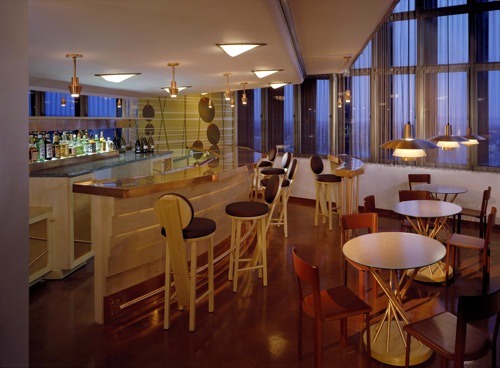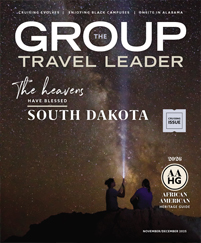
Courtesy Price Tower Arts Center
Tulsa, Okla., native Cyrus Avery was one of the major forces behind the creation of Route 66 in the 1920s and saw to it that more than 400 miles of the Mother Road, which ran from Chicago to Los Angeles, went through his native state. A large section of the road went through the northeastern part of the state that today bills itself as Oklahoma’s Green Country.
“He made certain that a great part of it zoomed through our area,” said Nancy Phillips, marketing director for the Green Country Marketing Association.
Although Interstate 44 has largely supplanted Route 66 in Green Country, small stretches of the road and many of its iconic roadside attractions are still visible. The route makes a great avenue for exploring Green Country, which is a microcosm of Oklahoma’s rich and colorful history of cowboys, Indians and oil barons.
Get your kicks
Entering Oklahoma from southwestern Missouri along the path of Route 66, you soon come to Miami — “We pronounce it My-am-uh,” said Phillips. Just outside the charming small town is a three-mile section of the original Route 66’s nine-foot-wide roadbed, one of only two sections of the original road that remain intact.
The Coleman Theatre, built in 1929 in downtown Miami, was a Route 66 landmark. The refurbished theater is adorned with hand-carved terra-cotta gargoyles, and the interior has gold-leaf trim, stained glass, a 2,000-pound chandelier and its original Wurlitzer pipe organ.
Also worth a stop in Miami is the Route 66 Vintage Iron Motorcycle Museum, which has collections of motorcycles and other memorabilia from Steven McQueen and Evel Knievel, along with a number of vintage motorcycles.
After visiting Miami, head to Grove on the shores of Grand Lake o’ the Cherokees, the largest lake in the state and one of several man-made lakes in the region. There, Har-Ber Village is a reconstructed early-20th-century village with 116 buildings containing a variety of antiques and collectibles.
“It’s a little jewel,” said Todd Stallbaumer of the Oklahoma Tourism Department.
Striking oil
After a Japanese tea ceremony at Londonwood Gardens, head northwest to Bartlesville and an immersion in Oklahoma’s oil history.
“Oil is certainly something Oklahoma is well known for,” said Phillips.
Another Phillips, oilman Frank Phillips, founder of Phillips Petroleum Co., built a 26-room mansion in Bartlesville in 1908 that is kept as a museum with many of the family furnishings still in place, providing insight into the personal life of an oil baron.
The Phillips Petroleum Company Museum in Bartlesville gives an informative look at the company, which Frank and his brother L.E. founded in 1917 by consolidating their various oil holdings.
Frank Phillips built a retreat about 12 miles from Bartlesville that is also preserved for the public. Woolaroc, named for its setting in woods, lakes and rocks, contains a 3,700-acre wildlife preserve with animals such as bison and elk; the original rustic lodge where Phillips entertained friends, dignitaries and business associates; and a museum with a world-class collection of Native American and Western art and one of the world’s largest collections of Colt firearms.
Back in Bartlesville, the futuristic-looking Price Tower Arts Center, the only skyscraper designed by Frank Lloyd Wright, towers above the city. Originally built in the mid-1950s as the headquarters for the H.C. Price Co., an international pipeline company, the tower now contains an art gallery, a hotel and a restaurant.
“We are also a museum,” said Debra Woodall, marketing manager for the tower. The top three floors have been restored to how they looked when they were the offices of the Price company.
Another major player on the Oklahoma oil scene was E.W. Marland, the founder of Conoco, who later served as governor. Marland built two large mansions in Ponca City, including the Marland Mansion, known as the Palace on the Plains (see “It’s Personal” story).
“The thing I find so interesting is to go to his home prior to Marland Mansion,” said Nancy Phillips.
“It’s called the Marland Grand Home,” said Crystal Bickford, tourism coordinator for Ponca City Tourism. “It’s a 22-room house with a central vacuuming system and an automatic dishwasher. It was built in 1914, and to have an automatic dishwasher then was a big deal.
“It also had the first indoor swimming pool in Oklahoma. In the lower level, you can learn about cowboys and see memorabilia from the famous 101 Ranch, which was just outside Ponca City. On the second floor is an extensive collection of Native American memorabilia.
“At the Conoco Museum, you can be immersed in the history of Conoco, the company E.W. Marland built,” said Bickford. “It has flat-screen televisions, interactive games and kiosks.”
In 1930, Marland paid for the 17-foot-tall bronze “Pioneer Woman” statue in Ponca City as a gift to the people of Oklahoma. In 1958, on the 65th anniversary of the Cherokee Strip Run, a museum was added at the statue site honoring women who have contributed to Oklahoma’s history and development.









